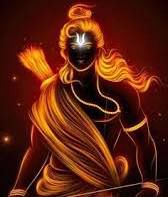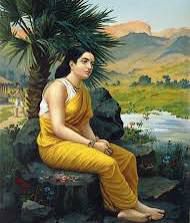
Prabhu Shri Ramachandra:
(This snippet from the Ramayana is a gift to friends from Sri Lanka, who might appreciate the story’s significance.)
By Lokanath Mishra
In the ancient city of Ayodhya, King Dasharath, a just and wise ruler, lived with his three queens: Kaushalya, Sumitra, and Kaikeyi. Despite their noble lineage, the royal family was childless, which caused them great sorrow.
King Dasharath, determined to have children, performed a sacred ritual, known as the “Putrakameshthi Yagna,” under the guidance of his spiritual advisor, Rishi Vashishta. The ritual was a plea to the gods to bless the king with offspring.
As a result of the ritual, a divine being appeared, carrying a sacred vessel filled with a divine porridge. The being instructed King Dasharath to distribute the porridge among his queens, which would enable them to conceive.
King Dasharath, overjoyed, shared the porridge among his three queens. Kaushalya, the first queen, received half of the porridge, while Kaikeyi, the second queen, received a quarter. The remaining quarter was given to Sumitra, the third queen, who received it in two portions.
As a result of consuming the divine porridge, the queens conceived. Kaushalya gave birth to Ramchandra, the eldest son, who was an incarnation of Lord Vishnu. Kaikeyi gave birth to Bharat, while Sumitra gave birth to twins, Lakshman and Shatrughna.
The four brothers grew up in a loving and nurturing environment, surrounded by their parents, teachers, and mentors. They were trained in the arts of warfare, governance, and spirituality, preparing them for their future roles.
The birth of the four brothers marked the beginning of a new era in Ayodhya, filled with promise, adventure, and destiny. Little did they know that their lives would be intertwined with divine purpose, epic battles, and ultimate triumph.
The divine prince of King Dasharath and Queen Kaushalya, Ramchandra, was an incarnation of Lord Vishnu, the preserver of the universe. From a young age, Ramchandra’s life was marked by extraordinary events and divine interventions.
As a prince, Ramchandra was trained in the art of warfare, governance, and spirituality. He was beloved by his parents, his brothers, and the people of Ayodhya. His reputation as a just and compassionate leader spread far and wide.
Sita Swayamvar:
Sita Swayamvar was a pivotal event in the life of Sita, the beloved wife of Lord Rama. It was a ceremony where Sita, the daughter of King Janaka, chose her husband from among various suitors.
King Janaka had announced that whoever could lift and string the sacred bow of Lord Shiva, known as the “Pinaka,” would be worthy of marrying Sita. Many powerful kings and princes attempted to lift the bow, but none could succeed.
When Lord Rama, along with his brother Lakshmana, arrived at the ceremony, he effortlessly lifted and strung the bow, breaking it in the process. This feat impressed King Janaka, who declared Rama as the worthy suitor for Sita’s hand.
The Swayamvar ceremony was a significant moment in the epic Ramayana, as it marked the beginning of Rama and Sita’s journey together. Sita’s choice of Rama as her husband was not only a testament to her devotion but also a demonstration of Rama’s exceptional strength, courage, and character.
The event has been celebrated in various forms of art, literature, and music, symbolizing the union of two divine souls and the triumph of good over evil.
After marriage Prabhu Rama Chandra and Mata Sita lived happily for few days. However, fate had other plans for Ramchandra. His stepmother, Queen Kaikeyi, manipulated King Dasharath into banishing Ramchandra to the forest for 14 years. Ramchandra accepted his father’s decision with humility and devotion, demonstrating his commitment to duty and righteousness.
Accompanied by his devoted wife, Sita, and loyal brother, Lakshman, Ramchandra embarked on a journey through the forest. Along the way, they encountered numerous challenges, including fierce demons and treacherous terrain.
Sita’s abduction by Ravana:
Sita’s abduction by Ravana is a pivotal event in the Hindu epic Ramayana. Ravana, the powerful king of Lanka, was determined to avenge his sister’s humiliation and sought to kidnap Sita, the wife of Lord Rama.
Disguising himself as a beggar, Ravana approached Sita, who was living in the forest with Rama and Lakshmana. He deceived her and abducted her, taking her to his kingdom in Lanka.
Rama and Lakshmana searched for Sita, but she was nowhere to be found. They eventually discovered that she had been taken by Ravana and vowed to rescue her.
The abduction of Sita led to a great war between Rama’s forces, led by Hanuman and Sugriva, and Ravana’s army. Rama ultimately defeated Ravana and rescued Sita, restoring honor and justice.
The epic battle between Rama and Ravana is a pivotal event in the Hindu epic Ramayana. It was a clash between good and evil, with Rama representing righteousness and Ravana embodying arrogance and ego-driven chaos .

The Battle Begins
Ravana, fueled by anger, unleashed a barrage of arrows at Rama, but Rama countered each attack with his exceptional archery skills. The battle raged on, with both warriors showcasing their mastery of mystic missiles and supernatural weapons .

Ravana’s Tactics
Ravana employed various tactics, including sorcery and dark magic, but Rama remained steadfast, using mantras to neutralize the attacks. Ravana’s sons and brothers, including Indrajit and Kumbhakarana, joined the battle, but Rama and his allies, including Lakshmana and Hanuman, fought valiantly against them .
The Turning Point

As the battle unfolded, Ravana’s strength began to wane, and Rama sensed victory within reach. Ravana’s dismissal of Vibhishana, who had defected to Rama’s side, marked a turning point in the battle. Vibhishana’s departure weakened Ravana’s defenses and paved the way for Rama’s ultimate triumph .
The Final Confrontation

In the final confrontation, Rama faced Ravana alone, determined to end the battle. Ravana unleashed his deadliest astra, but Rama countered it with his own divine weapon. With a swift arrow, Rama struck Ravana’s heart, ending his reign of terror .
Aftermath
As Ravana’s lifeless body descended, his face transformed from one of cruelty to calm and devotion. Rama, Lakshmana, and Hanuman paid their respects, and Rama instructed Vibhishana to perform Ravana’s final rites with solemn honor .
This epic battle symbolizes the eternal struggle between good and evil, with Rama’s victory serving as a testament to the power of righteousness and morality.
This event is often seen as a symbol of the struggle between good and evil, with Rama representing righteousness and Ravana embodying evil. Sita’s abduction and subsequent rescue are celebrated in various forms of art, literature, and music, highlighting the epic’s enduring themes and characters.
One of the most iconic episodes in Ramchandra’s life was his battle with Ravana, the powerful king of Lanka. Ravana, who was a devotee of Lord Shiva, had grown arrogant and was terrorizing the world. Ramchandra, with the help of his allies, including Hanuman and Sugriva, waged a fierce battle against Ravana and ultimately emerged victorious.
Throughout his journey, Ramchandra demonstrated extraordinary qualities, including compassion, forgiveness, and self-discipline. His life was a testament to the power of righteousness and the importance of upholding dharma, or duty.
After 14 years in exile, Ramchandra returned to Ayodhya, where he was welcomed as a hero. He became the king of Ayodhya, ruling with wisdom, justice, and compassion. His reign, known as the “Ram Rajya,” was a golden age, marked by peace, prosperity, and happiness.
To this day, Ramchandra is revered as a divine hero, an incarnation of Lord Vishnu. His life and teachings continue to inspire and guide people around the world, offering valuable lessons on duty, morality, and spirituality.
